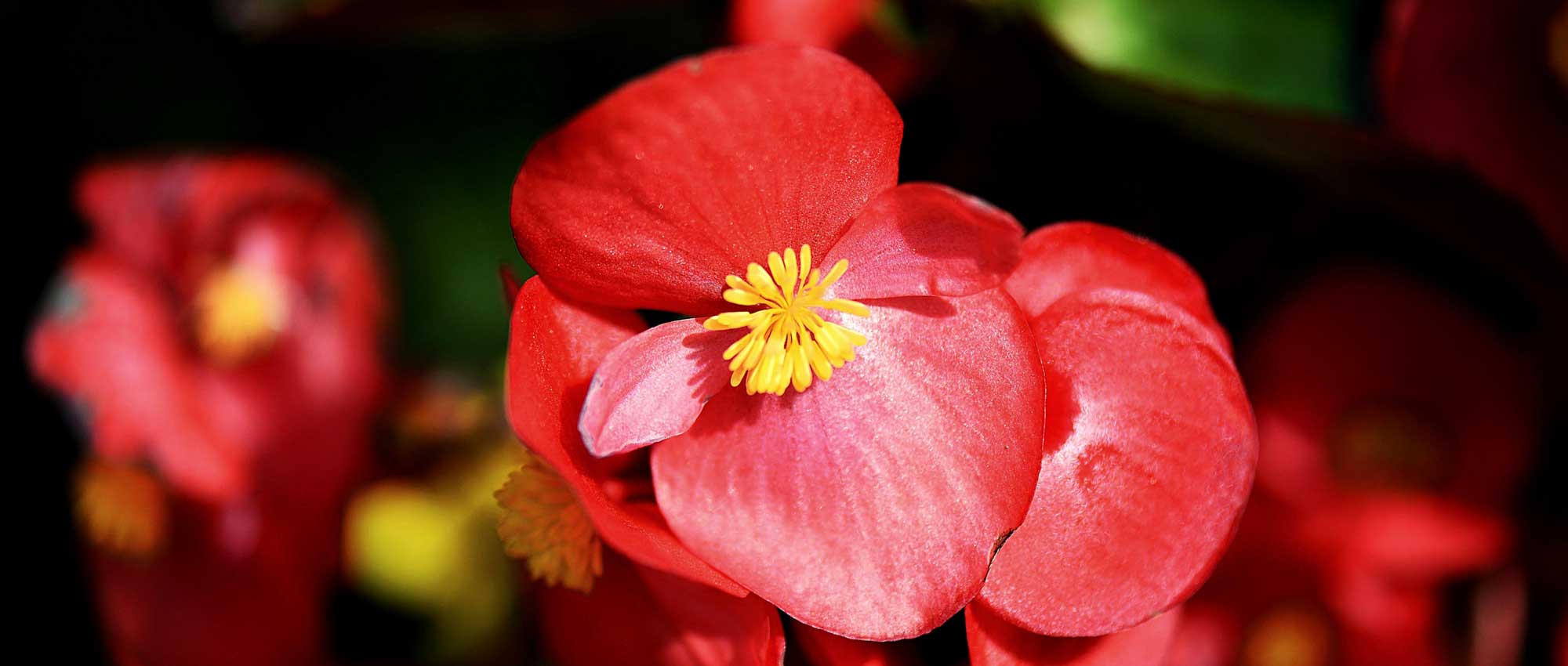
Begonias for borders: to plant, to grow and to maintain
Contents
Begonias in a nutshell
- Begonias offer a generous flowering in shade that lasts all summer!
- Their flowers are impressive with their bright and vivid tones, often pink, red, or white…
- They are also appreciated for their decorative and glossy foliage, green, purple, or bronze.
- Very popular and easy to grow, they can be planted in borders, as well as in pots or window boxes!
- It is an ideal plant to quickly bring a lot of colour to the garden.
A word from our Expert
Often referred to as “annual begonias,” bedding begonias are perennial plants but not hardy, requiring protection during winter. These are Begonia semperflorens: they are plants that bloom for a long time, from spring to autumn, in white, red, or pink shades! Depending on the varieties, the flowering can be single or double (in pom-poms!). They also offer decorative foliage, rounded and fleshy, glossy, which can be green, bronze, or purple.
Unfortunately, the begonia semperflorens is not hardy, which is why it is often treated as an annual! It is extremely easy to grow and grows quite quickly. It should be planted in spring, in full sun or partial shade, in light, well-draining soil. Although it is generally planted in beds, it can also adapt to pot or container cultivation. For maintenance, we recommend regular watering during the summer, removing faded flowers, and applying mulch. Begonia semperflorens can be propagated by sowing or propagation by cuttings. You can also bring it indoors for winter to keep it for several years.
It is a very popular plant, often used to brighten up urban green spaces, which can be attributed to its abundant and long-lasting colourful flowering, as well as its ease of cultivation… The begonia is perfect for quickly adding a lot of colour to flower beds!
Description and Botany
Botanical data
- Latin name Begonia semperflorens
- Family Begoniaceae
- Common name Bedding begonia, annual begonia
- Flowering summer
- Height between 15 and 30 cm
- Exposure sun or partial shade
- Soil type rich, cool, well-drained
- Hardiness between 0 and -5 °C
Les begonias sont des plantes souvent herbacées et charnues, aux tissus épais. C’est un groupe très diversifié, qui compte environ 1 600 espèces, ce qui en fait l’un des plus grands genres du règne végétal. Ces espèces s’hybrident facilement entre elles, et ont permis de créer d’innombrables variétés horticoles ! Elles proviennent des régions tropicales et subtropicales : on les trouve en Amérique du Sud et centrale, en Afrique subsaharienne et en Asie. Beaucoup sont originaires de forêts humides. Certains begonias ont des rhizomes ou des tubercules. Ils sont appréciés pour leur floraison, et parfois leur feuillage extrêmement décoratif. Ce sont des plantes peu rustiques, ce qui explique qu’une partie des begonias sont plutôt destinés à la culture en intérieur.
Les begonias à massif sont issus du Begonia semperflorens, une plante qui vient du Brésil. Ils sont appréciés pour leur longue floraison colorée et leur feuillage décoratif, et sont parfaits pour fleurir les massifs et parterres… Bien qu’ils soient souvent appelés annual begonias, il s’agit en réalité de plantes vivaces, mais cultivées comme des annuelles en raison de leur manque de rusticité.
Les begonias ont commencé à être cultivés dans des jardins botaniques d’Europe à la fin du 18ème siècle, et il faudra attendre 1820 pour que débute la culture des premiers Begonia semperflorens (synonyme de Begonia cucullata). Ces derniers ont été hybridés avec le Begonia schmidtiana pour donner les begonias à massifs que l’on connait aujourd’hui. Le begonia à massifs est souvent appelé Begonia x semperflorens-cultorum.
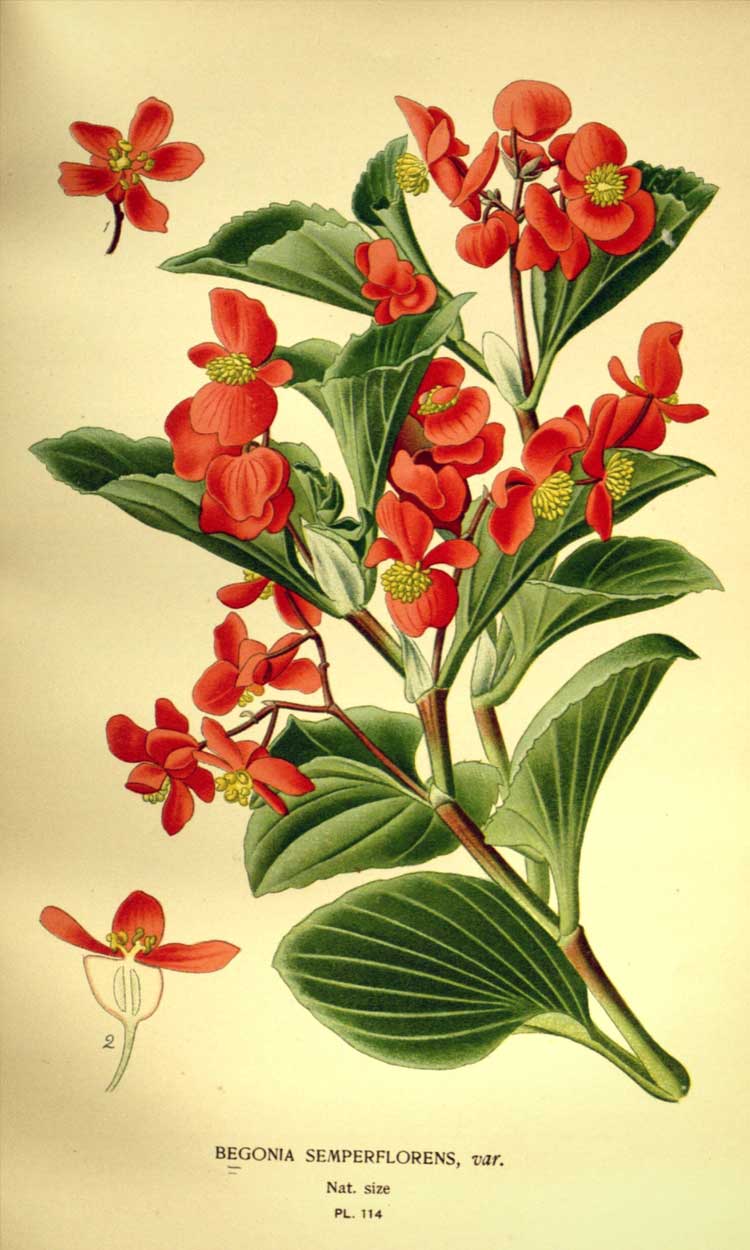
Begonia semperflorens: botanical illustration
Les begonias ont leur propre famille botanique, les Begoniacées, dont ils sont quasiment les seuls représentants ! En effet, cette famille ne compte qu’un seul autre genre végétal, les Hillebrandia, dont il n’existe qu’une seule espèce (Hillebrandia sandwicensis).
Le Begonia a été nommé ainsi par le botaniste Charles Plumier au 17ème siècle en hommage à Michel Bégon, qui fut gouverneur de Saint-Domingue, intendant de la marine de Rochefort, et qui collectionnait les plantes. C’est lui qui envoya Charles Plumier aux Antilles pour y étudier la flore. Celui-ci y découvrit le begonia et lui donna en retour ce nom. Quant au nom d’espèce, Semperflorens, il signifie always in flower… Et en effet, sous nos latitudes, la floraison est stoppée en automne par le froid, mais, sous un climat chaud (ou si vous les rentrez pour l’hiver), ils peuvent fleurir toute l’année ! En anglais, on les appelle wax begonias : Wax begonias, en raison de leurs feuilles brillantes.
Le begonia forme une touffe au port compact et dense. C’est une plante qui pousse rapidement. Il atteint souvent autour d’une vingtaine de centimètres de haut, mais, suivant les variétés, il peut mesurer entre 15 cm et 30-35 cm de hauteur. Cependant, les begonias de la série ‘Big’ (par exemple, ‘Big Red’ Bronze Leaf’) sont bien plus grands, puisqu’ils peuvent atteindre 60 cm de haut ! Les tiges du begonia sont charnues, épaisses. Il est fréquent que les tissus, tiges et feuilles, se nuancent légèrement de rouge.
Globalement, les dimensions et formes des begonias à massif sont assez uniformes. Et dans les couleurs, au sein d’une même variété, les teintes de fleurs varient très peu. C’est d’ailleurs ce qui permet de les utiliser facilement en mosaïculture. Ils forment toujours des touffes arrondies, denses et colorées, assez similaires d’un plant à un autre.
Le begonia semperflorens offre une longue floraison qui dure tout l’été ! Il fleurit à partir de mai-juin, et jusqu’aux gelées (octobre-novembre). Sa floraison n’est stoppée que par le froid : si vous le rentrez sous abri pour l’hiver, il peut fleurir toute l’année.
Il offre une floraison très généreuse, composée d’une multitude de fleurs blanches, roses ou rouges. Leurs teintes sont souvent très vives, éclatantes… Elles attirent l’attention, apportant beaucoup de luminosité et de couleur dans les massifs ! Les fleurs peuvent aussi être plus ou moins bicolores, comme chez le Begonia ‘Super Olympia Bicolore’ qui porte des pétales rose tendre bordés d’un rose plus prononcé.
Les fleurs mesurent jusqu’à 3 ou 4 centimètres de diamètre au maximum. Elles sont ordinairement composées de quatre tépales (sépales ou pétales indéterminés) : deux opposés assez larges, et deux plus petits. Au centre de la fleur, des étamines (fleurs mâles) ou stigmates (fleurs femelles) de couleur jaune vif attirent l’attention, donnant davantage d’éclat à la floraison ! Les fleurs du begonia sont unisexuées : elles peuvent être mâles (avec des étamines) ou femelles (pistils). Chez les fleurs femelles, l’ovaire est situé juste sous les sépales, et forme trois ailes. Les fleurs sont souvent simples (avec quatre sépales), mais peuvent aussi être doubles, avec une multitude de pétales, comme chez la variété ‘Doublet Rose’… Les fleurs ressemblent alors à de petits pompons !
Les fleurs des begonias annuels sont disposées en grappes. Elles sont portées très proches de la touffe, ce qui lui donne un aspect compact, à la différence d’autres plantes qui portent leurs fleurs loin au-dessus du feuillage.

The flowering of begonias: Begonia ‘Big Red Bronze Leaf’, Begonia semperflorens ‘Doublet Rose’, and Begonia semperflorens ‘Super Olympia White’ (photo David J. Stang)
Le begonia semperflorens possède des feuilles simples, entières, de forme ovale et plus ou moins cordée, légèrement dentées ou crénelées sur le bord du limbe. Les nervures sont palmées. Elles sont alternes, placées les unes après les autres sur les tiges. Les feuilles épaisses, charnues, du begonia l’aident à mieux supporter la sécheresse. Elles sont luisantes, comme vernies, ce qui leur vaut en anglais leur nom de Wax begonias, Wax begonia. La base du limbe est asymétrique, généralement plus large d’un côté que de l’autre. Les feuilles mesurent souvent environ 5 centimètres de longueur, mais peuvent atteindre jusqu’à une dizaine de centimètres chez certaines variétés.
Les feuilles sont souvent d’un vert profond, mais peuvent aussi être bronze ou pourprées. Chez la variété ‘Doublet Rose’, la floraison est particulièrement mise en valeur par le feuillage très sombre, bronze. Même lorsqu’elles sont vertes, il arrive que les feuilles prennent de légères nuances de rouge, notamment en bordure du limbe.

The foliage of begonias can be green (Begonia semperflorens ‘Olympia Pink’), bronze (Begonia semperflorens ‘Eureka Bronze Leaf White’, photo David J. Stang), and sometimes almost black (photo Mariiapulido)
Les racines sont fasciculées et fibreuses, contrairement à d’autres begonias qui ont des racines rhizomateuses ou tubéreuses.
Le fruit du begonia est une capsule à trois ailes, et qui à maturité devient sèche et brune, s’ouvrant alors pour libérer les graines. Celles-ci sont minuscules : parmi les plus petites du règne végétal… On compte plus de 50 000 graines par gramme ! Cela rend leur semis délicat. Pour les semer, mieux vaut les mélanger à du sable afin de les répartir plus facilement sur le substrat.
The main varieties
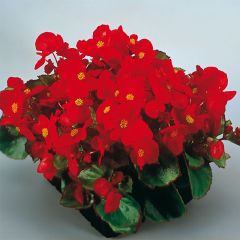
Begonia semperflorens Super Olympia Red
- Flowering time July to November
- Height at maturity 20 cm
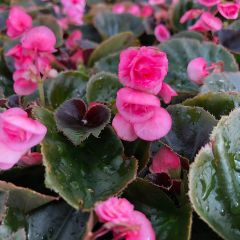
Begonia semperflorens Doublet Pink
- Flowering time June to December
- Height at maturity 30 cm

Begonia semperflorens Super Olympia blanc
- Flowering time June to December
- Height at maturity 20 cm
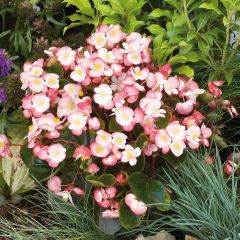
Begonia semperflorens Maxima Rose Bicolor
- Flowering time June to December
- Height at maturity 20 cm
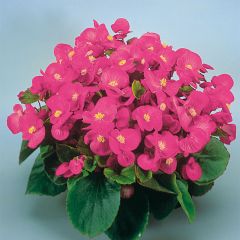
Begonia semperflorens Super Olympia Pink
- Flowering time June to December
- Height at maturity 20 cm
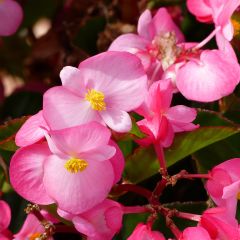
Begonia Big F1 soft pink
- Flowering time June to December
- Height at maturity 75 cm
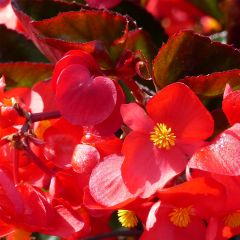
Begonia semperflorens F1 Red With Bronze Leaf
- Flowering time May to November
- Height at maturity 40 cm
Discover also the Begonia grandis, a hardy perennial begonia that can stay outside in winter! It is rather a shade plant.
Discover other Begonia
View all →Available in 2 sizes
Available in 2 sizes
Available in 1 sizes
Available in 0 sizes
Available in 0 sizes
Available in 1 sizes
Available in 1 sizes
Available in 3 sizes
Available in 1 sizes
Available in 1 sizes
Young plantation
Where to plant?
Plant begonias in full sun or partial shade. They enjoy bright locations but do not like scorching sun: in the south of France, in the Mediterranean region, it is better to plant them in a spot where they will have shade during the hottest hours. However, varieties with dark, purple, or bronze leaves tolerate full sun better than those with green leaves. Areas with too much shade may limit flowering.
They prefer slightly acidic or neutral soils rather than calcareous substrates.
Plant them in light, airy, and well-drained soil, which allows water to quickly infiltrate the ground. They do not appreciate heavy, compact, clayey soils that could suffocate the roots. They dislike waterlogged soils, which can lead to fungal diseases. You can add some coarse sand, pumice, or leaf mould.
Begonias thrive in humus-bearing soils rich in organic matter. It is advisable to add well-decomposed compost at the time of planting.
You can grow them in pots or containers, and place them on a windowsill, balcony, or terrace. Preferably choose a pot that is not too deep or too large, and take the opportunity to create colourful compositions. If you grow them in pots, do not hesitate to bring them indoors as soon as winter begins to arrive: this way, you can keep them for several years!
It is also possible to grow semperflorens begonias as houseplants all year round.
When to plant?
Install begonias in spring: they can be planted from April and May, as soon as there is no longer a risk of frost.
How to plant?
In the ground:
Maintain a distance of 15 to 20 cm between the plants.
- Place the root ball in a basin filled with water for about ten minutes.
- While it is soaking, prepare the soil by loosening it and removing weeds. Add well-decomposed compost to enrich the soil.
- Dig a planting hole slightly larger than the root ball.
- Remove the begonia from its pot, place it in the planting hole, then replace the soil and firm it all around with the palm of your hand.
- Water generously.
Ensure regular watering in the weeks following planting, until the plant is well established. We also recommend applying a layer of mulch around its base to keep the soil cool. Begonias will also appreciate a fertiliser boost.
In pots or containers:
Even though they are called bedding begonias, it is possible to grow them in pots or containers. The advantage is that you can easily bring them indoors for winter, thus keeping them for several years.
Take a pot, then place a drainage layer at the bottom (broken pots, gravel…). Fill the pot with potting soil and plant your begonia. Firm the soil around it, and water generously. Feel free to add other flowering plants alongside to create a composition.
→ Learn more with our tutorials: How to make a hanging begonia display? and How to make a begonia planter?
Read also
How to force a tuberous begonia?Maintenance
Begonias tolerate drought quite well once established, but it is nevertheless preferable to water them regularly, especially during hot weather, as this will encourage good flowering. Water begonias at the base, avoiding wetting the leaves to limit the risk of diseases such as powdery mildew. Be cautious of excess moisture; the soil should not be waterlogged (hence the importance of growing them in well-draining substrate). Allow the soil to dry out between waterings.
We advise you to remove the faded flowers, as this will encourage the appearance of new blooms.
It is always preferable to install a mulch to keep the soil cool. This will reduce the need for watering as well as weeding, by preventing weeds from growing. You can use, for example, dead leaves or ramial chipped wood (BRF).
Begonias are not hardy. They are likely to die at the first frosts. You can remove them to replant new ones the following year, which is the most common practice. But you can also choose to keep them by bringing them indoors for the winter like dahlias. (It’s even easier if you grow them in pots or containers!) The begonia is a perennial plant; it is just not hardy! It can live for several years if you protect it from the cold. Clean the clump by removing damaged leaves, place it in a bright and airy spot, and reduce watering. Bring it back outside in spring. A begonia brought indoors for winter can theoretically bloom all year round!
If you grow them in pots, you will need to repot them once a year, preferably in spring. Remove the root ball from the pot, gently scrape the outside to loosen the roots, and repot the begonia in a slightly larger pot. Begonias grown in pots or containers will also appreciate regular applications of liquid fertiliser.
As for diseases, the begonia is sensitive to powdery mildew and botrytis. Powdery mildew is characterised by the presence of a white, powdery coating on the leaves. Botrytis causes the plants to “rot,” leading to necrosis, wilting, and a kind of “grey dust.” Avoid confined spaces, and do not plant your begonias too densely; air must be able to circulate. When watering, direct the stream towards the soil to avoid wetting the foliage. You can treat them by spraying sulphur or a horsetail decoction.
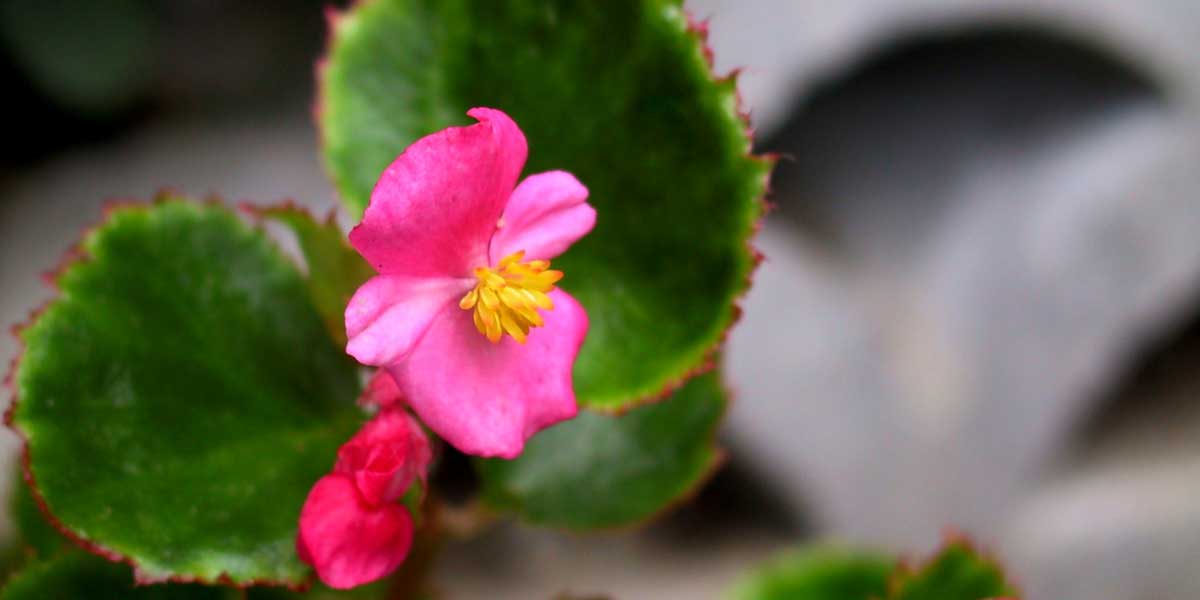
Begonia propagation
Begonias are quite easy to propagate. The most commonly used technique is sowing, but it is simpler to buy young plants in buckets, which you will plant around May.
Sowing
Sow begonias in January or February, possibly until March. Depending on the sowing date, you can transplant in March or April, then install them in the ground around May. However, some varieties are sterile and do not produce seeds (notably those with double flowers).
The main difficulty with sowing begonias comes from the tiny size of the seeds: they are as fine as dust. It is therefore preferable to mix them with sand to handle and distribute them more easily over the substrate. Sometimes, coated seeds are available commercially to allow for better handling.
- Take a seed tray or shallow container and fill it with light, fine, sifted potting soil. You can use special seed compost.
- Firm the substrate and moisten it.
- Mix the seeds with river sand to facilitate handling, then scatter them over the surface of the potting soil. Do not cover them, as they need light to germinate.
- Water very lightly using a spray bottle.
- Place the tray in a bright location, but out of direct sunlight, and at a temperature between 20 and 25 °C. For example, place a glass plate over it to maintain a humid atmosphere. The seeds take about 15 days to germinate, sometimes less.
- Ventilate regularly to prevent the development of the Pythium fungus, which causes damping off.
- Transplant the young seedlings into individual pots as soon as they have reached a sufficient size for handling.
- You can plant your young plants in the garden from May onwards.
Be cautious of damping off. To prevent it, use healthy potting soil. You can treat it with a horsetail decoction or sprinkle it with finely crushed charcoal. You can also disinfect the pots and tools you use. Finally, it is important to ventilate from time to time.
Propagation by Cuttings
It is quite simple to multiply begonias by stem cuttings, an interesting technique to preserve varieties, and suitable if you bring begonias indoors for winter. Act in spring, around May. The cuttings root easily.
- Fill a pot with potting soil mixed with sand, and water it so that it is well moistened.
- Take a stem about 10 cm long (maximum) from the variety you wish to propagate. Cut cleanly, just below a node (the point where leaves attach to the stem).
- Remove the leaves from the base, leaving only one or two leaves at the top of the cutting. If there are flowers or flower buds, remove them.
- Make a hole in the potting soil using a stick or a small wooden rod.
- Plant the cutting in the substrate.
- Firm the soil around it to ensure good contact between the stem and the potting soil.
- You can optionally place a plastic bag over the pot to create a humid atmosphere. In this case, it will be necessary to ventilate from time to time.
- Place the pot in a bright location, without direct sunlight, at a temperature of around 20 °C.
Keep the substrate moist until the cutting takes root. You can then repot it.
Association
Make the most of begonias to create a vibrant summer display by pairing them with perennials and summer-flowering bulbs! Create a dazzling bed by planting begonias (especially the varieties with red flowers) alongside other flowers in shades of red, orange, and yellow: crocosmias, gladioli, cannas, freesias, or dahlias… Also, take advantage of the abundant yellow flowering of rudbeckias! You might consider placing the begonia in front of the Euphorbia griffithii and its red flowers! Add some dark, black, or purple foliage (phormiums, castor beans, pennisetum, elderberry ‘Black Lace’…), as they will complement these warm-toned flowers beautifully. Your garden is likely to take on an exotic appearance!
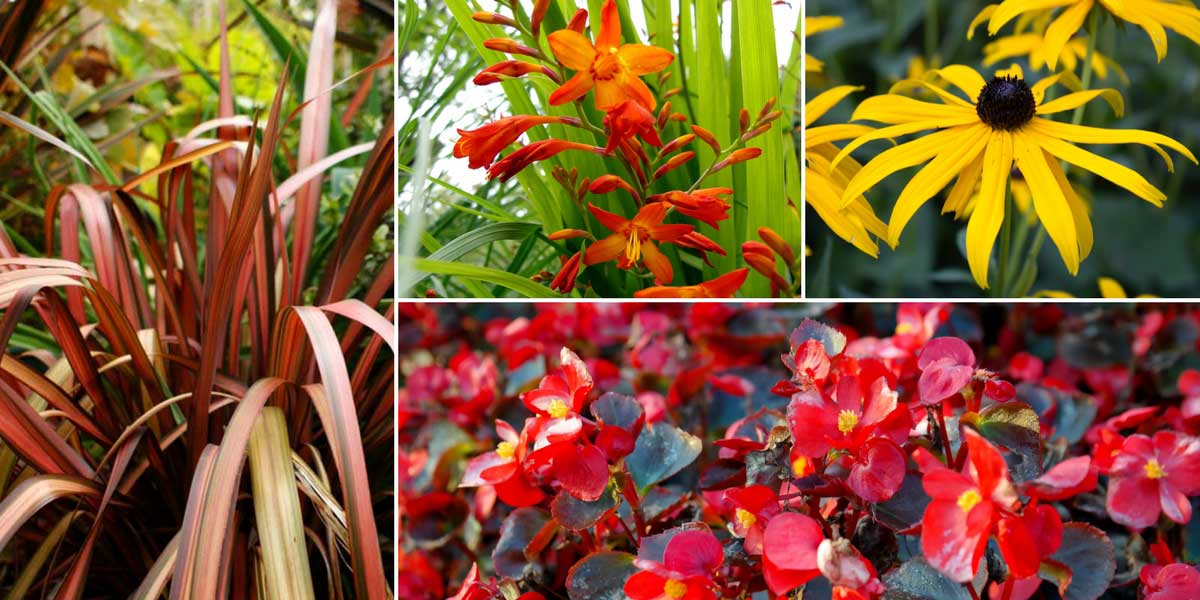
A pairing idea for a colourful bed: Phormium ‘Pink Panther’, Crocosmia, Rudbeckia hirta, and Begonia semperflorens
You can also, on the contrary, opt for light decorative foliage and more subdued, natural plants… This will further highlight the flowering of the begonia! The idea is to place a few touches of red, brought by the begonias, among lush, airy green foliage. In this case, pair them with grasses, ferns, persicarias, ipomoeas, or euphorbias… Preferably choose plants with an elongated silhouette and fairly fine leaves. To give volume and structure to your bed, position your begonias in front of taller plants: bushes, perennials with an upright habit, or fairly tall grasses.
If you choose to grow your begonias in pots or containers, you can pair them with pansies, osteospermums, verbenas, or decorative-leaved ipomoeas… Take the opportunity to brighten up your balconies and window sills! Add some grasses (Carex, Pennisetum…) to bring a touch of lightness and soften their very bright colours!
Begonias pair very well with the yellow flowers of bidens, which also last from spring to autumn, and can be grown as an annual or a perennial that is brought indoors for winter… Just like the begonia for beds! You can plant them together in containers that you can bring under cover as soon as the first frosts arrive.
You can combine different varieties of begonias to create cohesive arrangements or mix colours. Use begonias to compose colourful flowerbeds. When planted in masses, they create a focal point in the garden. They attract attention with their bright, homogeneous colours. They are often used in mosaiculture.
Ultimately, when pairing begonias, you have two main options: either marry them with many brightly coloured flowers to create an impressive, flamboyant ensemble, with very vivid shades, at the risk of achieving an artificial, even overwhelming, stifling appearance. Or integrate their flowers into lighter, more nuanced beds, with decorative foliage. This will enhance the individual flowers even more.
Did you know?
- Collections of begonias
Located in Rochefort, the Begonia Conservatory houses the national collection of the genus Begonia, with over 1,500 botanical species and horticultural varieties. The Botanical Garden of Lyon, on the other hand, possesses the national collection of botanical begonias.
- The diversity of begonias
Begonias are an impressive group due to their diversity! Some have long upright stems with swollen nodes, known as bamboo begonias (Begonia maculata), while others are shrubby or climbing (Begonia glabra)… Some begonias are epiphytic (Begonia quadrialata), growing on the trunks of other plants! Although most are tender, a few species are quite hardy, such as Begonia grandis, which can withstand temperatures between -15 and -20 °C. Similarly, while the majority of begonias are perennials, Begonia humilis is annual. Some form caudexes (Begonia dregei): the base of their trunk is swollen to store water! Others produce bulblets (Begonia evansiana): miniature begonias borne in the axil of the leaves, which then fall and root upon contact with the soil! The smallest begonias measure less than 10 cm tall (like Begonia prismatocarpa), while the largest can reach up to five metres!
The diversity of begonias is also reflected in their leaves, which can come in many shades: pink, red, green, silver, purple, black… sometimes featuring patterns of spots, stripes, or spirals! Some begonias have very dissected leaves, such as Begonia luxurians or Begonia carolineifolia… palmately lobed leaves with a very exotic appearance, truly different from those we are used to!
- An edible flower!
Begonia flowers are edible: they have a tangy and fruity flavour, with a crunchy texture. You can add them to fruit salads or use them to decorate dishes. Due to the presence of oxalic acid, it is advisable to consume them in small quantities.
Useful resources
- Discover our range of begonias!
- Our begonia seeds
- Also discover our advice sheet on planting begonias
- Learn more about forcing tuberous begonias and how to propagate tuberous begonia
- Check out Ingrid’s tutorials: how to create a hanging begonia display? and how to make a begonia planter?
- The website of the Begonia Conservatory, located in Rochefort, which houses the national begonia collection (CCVS)
- An article on the different types of begonias and their cultivation
- The website of the French Association of Begonia Enthusiasts (AFABEGO), with cultivation tips
- Find our tips for caring for your begonias in: Diseases and pests of begonias
Frequently asked questions
-
Can I keep my begonias from one year to the next?
Yes, although bedding begonias are generally grown as annuals, they are indeed perennial plants. They are not hardy, but simply bringing them indoors for the winter will allow you to keep them for several years!
-
My begonia has white, powdery spots on its leaves. What should I do?
It is affected by powdery mildew, also known as White Disease. If there are not too many, remove the affected leaves to limit the progression of the disease. Spray a solution based on sulphur. And avoid wetting the foliage when watering.
-
I sowed begonia seeds, but the young shoots are wilting and rotting. What is happening?
They are victims of damping-off, caused by the fungus Pythium, which is favoured by a humid and confined environment. It is difficult to save seedlings once the disease has set in. There are mainly preventive measures to avoid it: regularly aerate, water without excess, use a clean and healthy substrate, and possibly treat it with a horsetail decoction or by sprinkling charcoal (for its antifungal properties!).
-
My begonia seems to be rotting, it is wilting and its leaves are experiencing necrosis. What should I do?
It is affected by Botrytis cinerea, a fungal disease. The leaves bear brown spots, the stems become soft, and grey dust appears on the affected tissues... This fungus is favoured by excess moisture, a confined environment, low temperatures, and a lack of light. Remove and burn the affected leaves. We also advise you to ventilate, limit watering, and water at the base to avoid wetting the foliage. You can spray a solution based on sulphur or a horsetail decoction.
- Subscribe!
- Contents
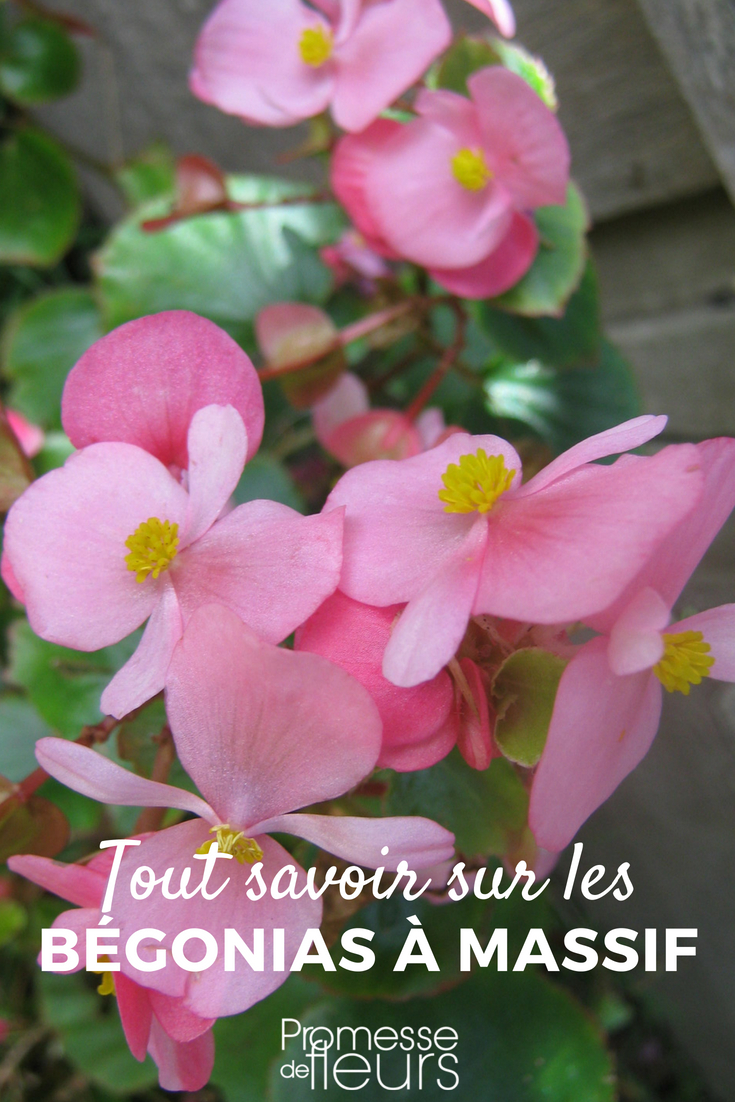



































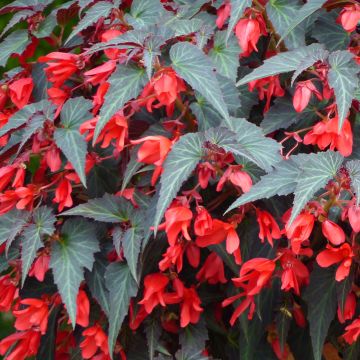
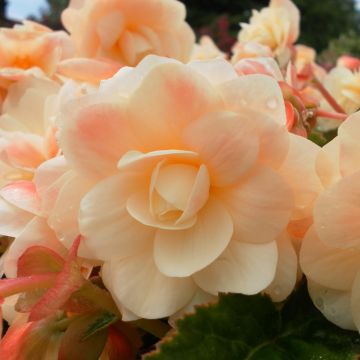
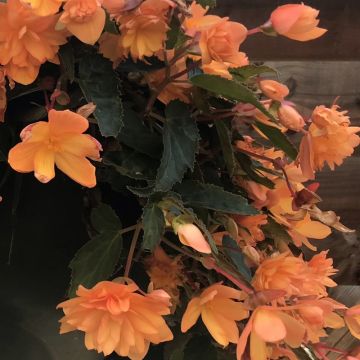
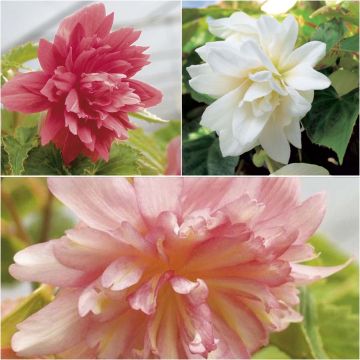
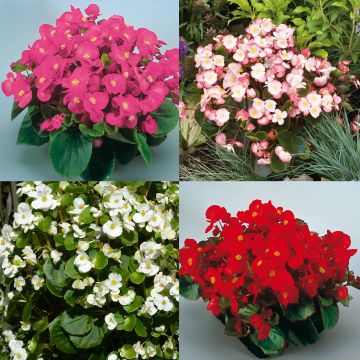
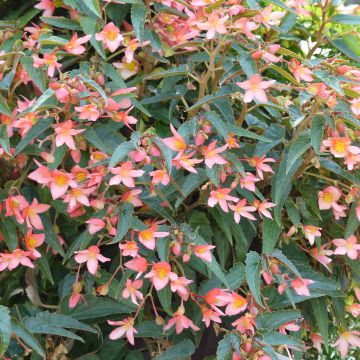
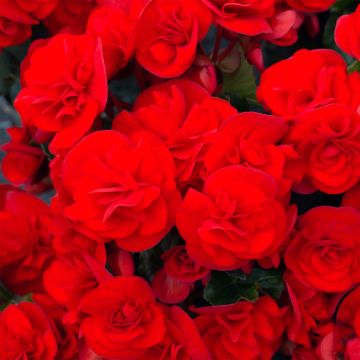
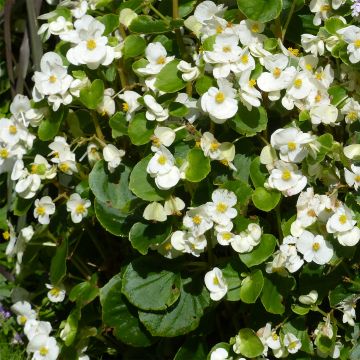


Comments